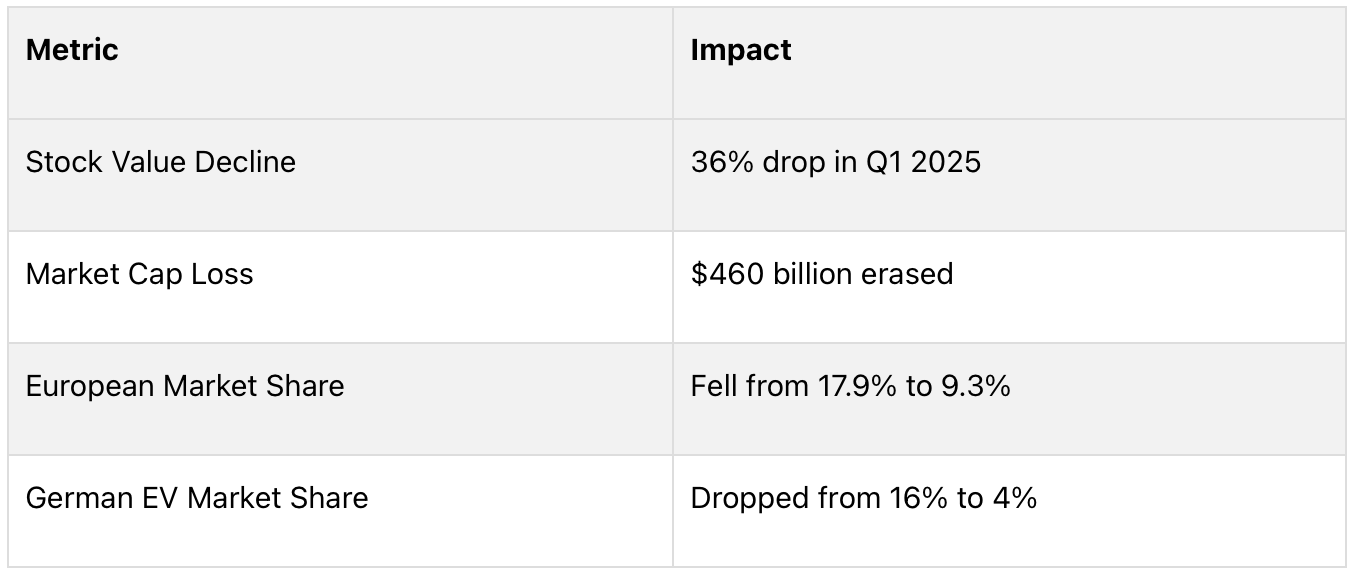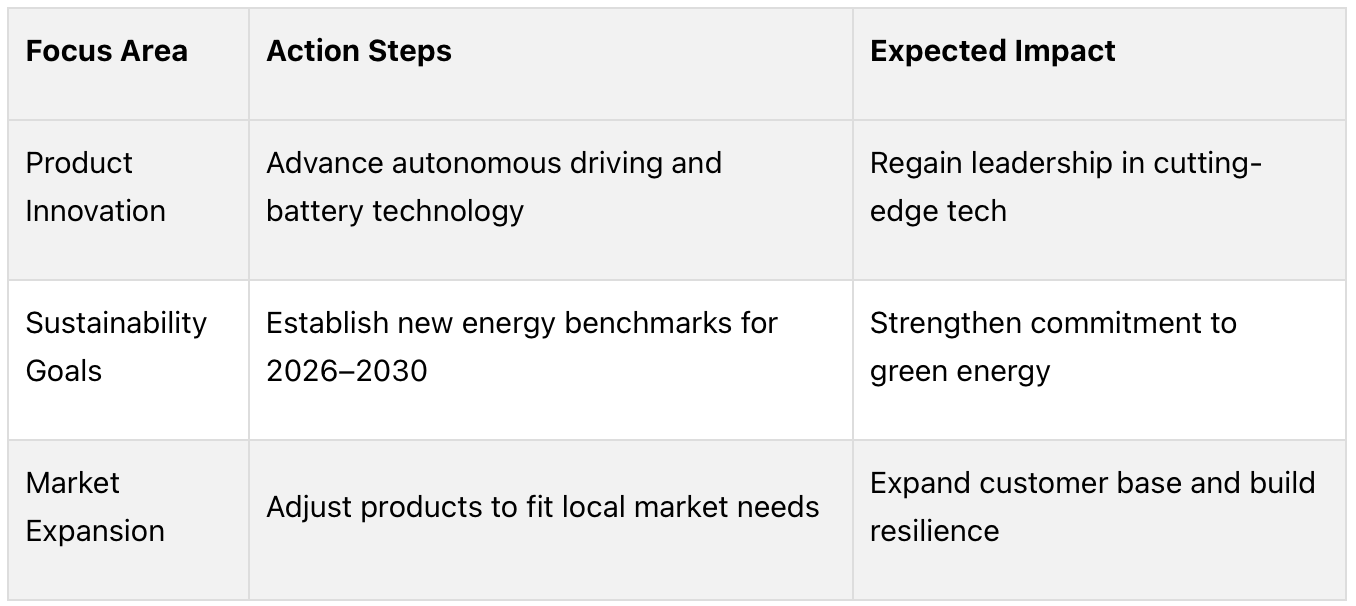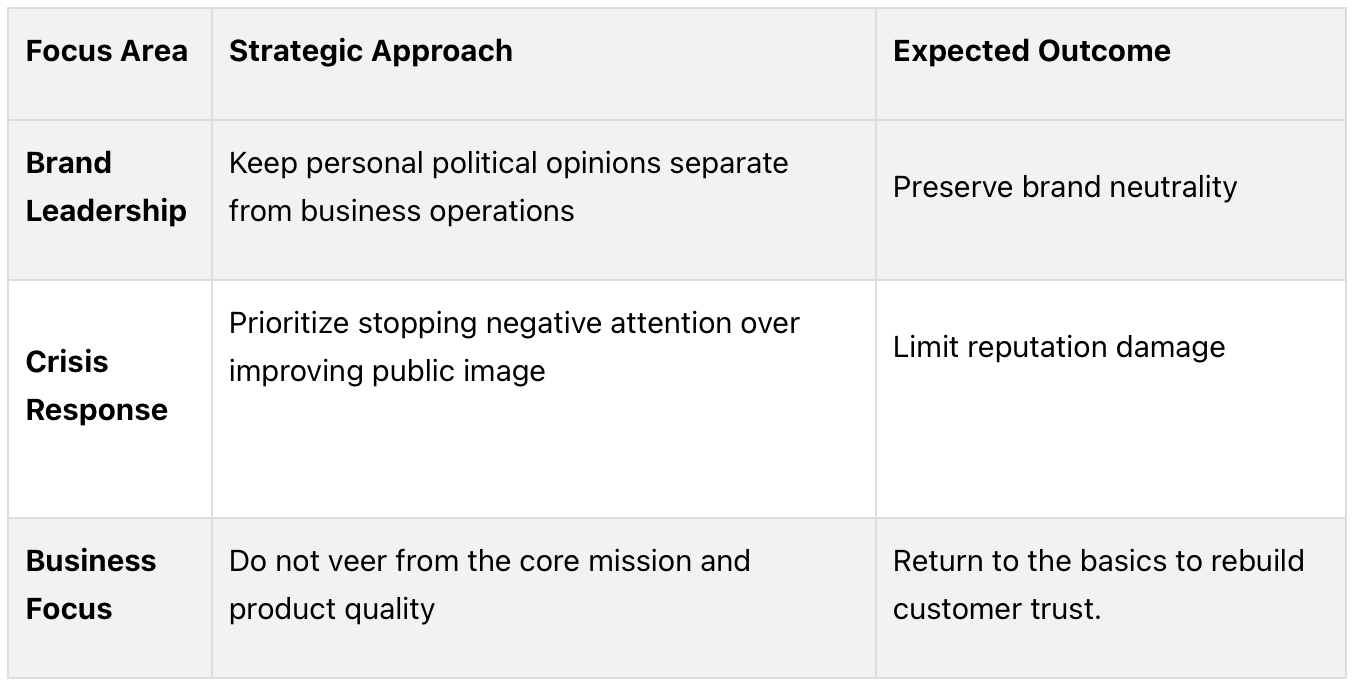What Every Company Can Learn from Tesla’s Brand Fallout
Tesla's recent struggles show how controversies can damage a brand. CEO Elon Musk's recent controvercial decisions have alienated a significant portion of Tesla's eco-conscious customer base. The fallout has been severe:
- Stock Decline: Tesla's stock dropped 36% in Q1 2025, erasing $460B in market cap.
- Sales Impact: Vehicle deliveries fell 13% year-over-year in Q1 2025, with market share in Europe and Germany plummeting.
- Customer Trust: Favorability among Democrats dropped 23% from January to July 2024, while Tesla's brand consideration score halved since 2021.
This highlights a key lesson: brands risk fallout when taking sides on divisive issues, and this is particularly true in politics. It highlights how important it for brands to remain focused on their core mission, establish authenticity, and earn trust from the market.
You may be asking yourself, well hold on, how is this any different that what other brands like Ben and Jerry’s have done over the years. The key difference is that even though they may express views that some may find divisive, these views didn’t counter their core brand essence, in fact it enhanced it.
Conflicts Hurting Brand Performance
Brand Value Losses
Tesla experienced a hit to its brand value following statements from its CEO that many perceived to be divisive or off-brand. Survey results showed that 45% of respondents viewed the impact as "negative," while 40% described it as "extremely negative" [2].
Customer Trust Breakdown
Tesla's favorability ratings have sharply declined, particularly across political affiliations:

The number of Tesla owners identifying as Democrats dropped from 39% in 2023 to 26% in 2024 [3]. In California - a key market for electric vehicles - registrations of the Model Y fell by 17% during Q1 2024 compared to the same period the previous year [3]. And this is before the actions taken by the Musk-led Department of Government Efficiency (DOGE).
These changes in consumer sentiment have led to immediate and vocal reactions from the public.
Political Actions and Public Response
Departing from Tesla's core brand image, the CEO's political endorsements sparked widespread backlash. At its core are the many Tesla consumers who eagerly bought Teslas because it aligned with support for green energy and sustainability initiatives.
"He has significantly alienated most of his buying base. It's going to kill the business. I can't imagine a single Democrat, or, let's say, very few of them, willing to buy a Tesla at this point", said investor Mark Spiegel [3].
"This final stance of Elon has put me in a really difficult moral position. I'm driving a Cybertruck and now it's like a MAGA truck," shared Ross Gerber, CEO of Gerber Kawasaki Wealth and Investment Management [3].
Public perception of Tesla has shifted dramatically, leading to protests at showrooms and incidents of vandalism targeting Tesla vehicles [1]. This growing public discontent signals deeper challenges for the brand, which will be explored further in the next section.
Are customers abandoning Tesla because of Elon Musk and ...
Business and Brand Damage
Tesla's involvement in contentious political matters has led to clear financial setbacks and damage to its reputation.
Q1 2025 Performance Drop
Tesla’s political controversies have shaken customer confidence, and the impact is now visible in its business results. The company delivered 336,681 vehicles in Q1 2025, marking a 13% drop compared to 386,810 units in Q1 2024 [4]. Here’s how key metrics reflect this downturn:

"We knew first quarter Tesla deliveries would be soft but these numbers were bad...they were a disaster on every metric. Refresh issues but brand crisis key." – Dan Ives, Wedbush Securities Analyst [4]
This decline goes beyond numbers - it’s also chipping away at Tesla’s identity as a market leader.
Decline in Environmental Leadership
Tesla’s position as a leader in sustainability has taken a hit. The company’s brand consideration score, which peaked at 70% in November 2021, plummeted to 31% by February 2025 [5]. Tim Calkins, a marketing expert from Northwestern University's Kellogg School of Management, explains: "It is hard enough to win sales without getting into politics." [5]
Erosion of Leadership Trust
Elon Musk’s political activities have further complicated Tesla's brand image. With 83% of Americans directly associating Musk with Tesla [5], his actions have become intertwined with the company’s reputation. Public trust is waning, as 42% of respondents held an unfavorable view of Musk in February 2024, compared to 34% in April 2022 [5].
"It's very likely that Musk himself is contributing to the reputational downfall." –Shahar Silbershatz, Caliber CEO [5]
Ed Kim, a crisis management expert at AutoPacific, adds: "A modest but growing number of EV shoppers are increasingly put off by Elon Musk's behavior and politics and are now finding viable alternatives to Tesla in the marketplace." [5]
How to Fix Brand Alignment
Return to Core Mission
Tesla needs to refocus on its primary goal: accelerating the transition to sustainable energy. This involves prioritizing innovation, setting clear objectives, and tailoring strategies to local markets.

By realigning internally, Tesla can begin to repair the trust lost due to recent political controversies. These adjustments also create a foundation for leveraging insights from the latest market research.
Improve Brand Management
Eric Dezenhall, a crisis management expert, advises focusing on operational excellence rather than political narratives [1]. For Tesla, this means shifting its messaging to spotlight product innovation and sustainability while steering clear of divisive topics. With 85% of investors expressing concerns about the negative impact of political involvement on Tesla [2], the company must prioritize rebuilding trust by staying true to its original mission.
Managing Risk in Brand Strategy
Tesla's situation highlights a key takeaway: diving into divisive issues can seriously damage a brand's reputation. The company's nearly 40% share drop in early 2025 [2] is a clear example of how political controversies can erode both brand value and customer confidence.
Crisis management expert Eric Dezenhall puts it plainly: "It's almost impossible to be a politically divisive figure while running a consumer brand" [1].
To handle these risks effectively, brands can focus on specific strategies. Here are three areas to consider:

These steps provide a clear path for addressing the damage. Dezenhall further emphasizes:
"The aim of crisis management is to stop an attack, not improve an image. First, get back to business. Leave politics to somebody else. This isn't your thing" [1].
To strengthen their position, brands should also rely on market research to guide their next moves. With 85% of stakeholders believing political involvement harms a brand [2], data-driven decisions can help leaders refocus on operational priorities and core values, ensuring long-term stability and success.

Tell us about your brand challenge
BOSTON
+ 978 462 0002
76 State Street, 4th Floor
Newburyport, MA 01950 USA
SHANGHAI
+ 86 21 6083 1177
4F, Anken Access
285 Anyuan Road
Jing'An District
Shanghia, China
Brandigo is a global strategic consultancy focused on building strong organizations through brand research, brand strategy development, brand and operational strategy alignment, visual identity and creative development, and employee engagement. We merge robust data and insights with strategic thinking to build brand strategies and creative that build meaningfully differentiated brands.
For marketing communication and activation in China, visit brandigochina.com
© 2025 Brandigo. All rights reserved.

